new posts in all blogs
Viewing Blog: Keith Mansfield, Most Recent at Top
Results 1 - 25 of 61

A blog from the author of the Johnny Mackintosh stories
Statistics for Keith Mansfield
Number of Readers that added this blog to their MyJacketFlap: 2
.jpeg?picon=3324)
By: Keith Mansfield,
on 11/15/2014
Blog:
Keith Mansfield
(
Login to Add to MyJacketFlap)
JacketFlap tags:
Film,
Science,
space,
Aliens,
Cinema,
Carl Sagan,
Brian Cox,
bfi,
Adam Rutherford,
Add a tag
As part of their brilliant science fiction season, last night BFI Southbank saw a special screening of Contact, a movie based on the novel by SETI pioneer, Carl Sagan.
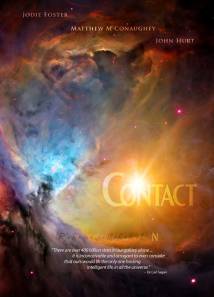 It’s not a short film, but no one in the packed audience minded that the Q&A preceding it, with Professor Brian Cox and Dr Adam Rutherford, took over an hour. Huge credit to my former employers, the British Film Institute, for not making it token, but giving us the chance for a meaty discussion on what many think is the most important question facing science: where is everybody?
It’s not a short film, but no one in the packed audience minded that the Q&A preceding it, with Professor Brian Cox and Dr Adam Rutherford, took over an hour. Huge credit to my former employers, the British Film Institute, for not making it token, but giving us the chance for a meaty discussion on what many think is the most important question facing science: where is everybody?
This was the question posed to colleagues over lunch one day (in 1950) by physicist Enrico Fermi. It has become known as the “Fermi paradox”. The “everybody” in question are aliens … extraterrestrials.
Why should we care?
Many people think the fundamental moment in the history of Western science was when Copernicus said Earth orbited the Sun rather than the other way around. This wasn’t simply a convenient coordinate shift. It was saying Earth is not the centre of the Universe. We inhabit just one of many planets. We have no privileged position in the cosmos. We are ordinary. The same “laws of nature” that apply on and around Earth apply equally in the rest of the Universe. This has become known as the “Copernican principle” and it is the foundation of scientific thought.
We have a problem. Look out at night – look further through our telescopes (and we can look so very far) and the Universe is vast. There are hundreds of billions of galaxies, like our own Milky Way. Just within ours, there are maybe 400 billion stars, most with planets. Conservative estimates, as Brian Cox told the audience (these are based on Kepler findings) hold that one in ten stars will have habitable planets in orbits that allow liquid water on their surface.
Further, at 4.5 billion years, Earth and our solar system are relatively young. The Milky War is far, far older. inally, mathematical models show it’s perfectly possible to colonize the entire galaxy in a brief time – say, 10 million years. Yet when we look skywards, we see not the slightest evidence if any intelligence in the entire Universe, other than what we find here on Earth. This suggests we are very special indeed – the polar opposite to the fundamental principle of science.

The Arecibo message
Sagan pondered this question long and hard. In his early, pioneering days of SETI, they were actively trying to communicate with extraterrestrials and before the movie, Cox and Rutherford were sitting in front of a radio message intentionally broadcast to the stars.
Sagan also helped designed messages added to the Voyager deep space probes (Voyager 1 is now over 18 light hours away, carrying a gold record with sounds of Earth and a map of how to find its inhabitants). Since those heady days, we think more about “existential risk” – things that potentially threated our survival as a species. One such risk is contact with alien races, so we’ve become more circumspect.
Looking back, I think the novel, Contact, was important for me as both a writer and publisher. I loved the story. It combined so many elements that I’m passionate about and, foolishly at the time I thought I could have told it better! Of course that’s not true, but I would nowadays have been a good editor for Sagan, had he let me. It certainly made me realize I was capable of being a good storyteller, and my current work-in-progress is a novel that revisits this same territory. I find it unfathomable now that I asked Sagan to sign my copy of Cosmos, which he kindly did, but not my copy of Contact – what was I thinking?
The film’s good, but there’s so much more in the book that anyone who likes the movie would get a lot from reading the novel. It was commented that Contact is a little overlooked as a science fiction film. Very true, but with my screenwriting hat on I think that’s because there’s so much to cram in, the narrative is very linear and straightforward. And Sagan’s thoughtful climax may have been unsatistfactory for mainstream audiences used to a different style of alien encounter.
In the movie, scientist Ellie Arroway (played by Jodie Foster and the character Cox and Rutherford said was the best depiction of a scientist on screen) detects a message from aliens, using radio telescopes. This was how Sagan and fellow SETI pioneer Frank Drake expected our first contact with extraterrestrials would go, and the film describes how things might unfold after receipt – the message is written in mathematics, the only universal language. There’s still an old-school SETI community working in this area, but increasingly scientists are thinking of alternative ways to identify evidence of aliens, often in the form of (very) large scale engineering projects such as Dyson spheres or matter-antimatter burners. We’re still looking.
If you’ve not seen the movie, you really should. Here’s the trailer to whet your appetite:
It’s part of the BFI’s excellent Sci-Fi: Days of Fear and Wonder season.


Back when Quercus books was starting out (even before they were called Quercus) I wrote a piece for them as proof of concept for a planned volume called Days that changed the World (to follow on from the successful Speeches that changed the World). In the end it became a book by Hywel Williams. I really liked my sample piece, mocked up for the Frankfurt bookfair, and now, on the 25th anniversary of the fall of the Berlin Wall, I’d like other people to be able to read it.

“Every wall will fall some day”
It was 6.57 pm on Thursday 9 November 1989. In a press conference Günter Schabowski, head of the Berlin section of East Germany’s ruling party the SED (Socialist Unity Party of Germany), was trying to answer a question put by an Italian journalist.
Earlier that day at the Politburo (Cabinet) meeting, the continued hemorrhaging of East German citizens to the West, through the increasingly open borders of its communist allies, had been discussed. It was decided that a system of permits would be introduced to allow travel into West Berlin. It was Günter Schabowski’s role to answer questions at the subsequent press conference, but he had only returned from holiday towards the end of the meeting and so missed much of the discussion. The question the journalist had asked was about this very issue of travel into West Berlin, so Schabowski was handed a piece of paper to help him give an answer. It was a press release intended for publication the following day. No one meant for him to read it out loud but that’s what he did. He was then asked when this would actually happen. Unaware of the proposed timetable he mistakenly announced to the surprised group of journalists before him that ‘this is immediate, without delay’.
‘As far as I know, this is immediate, without delay’ Günther Schabowski, Head of Berlin SED, 6:57pm
Within minutes the news wire services AP (Associated Press) and DPA (the German Press Agency) were reporting that East Germany had opened its borders to the West. The citizens of East Berlin flocked to the crossing points in the Wall hoping to gain access. Outnumbered and unprepared the border guards didn’t know what action to take. Telephone calls to their superiors apparently said ‘we’re flooding’ as they held back the ever-increasing crowds. Finally, around 10.30 pm at Bornholmer Strasse they bowed to the inevitable and opened the crossing. After 10,315 days stretching across 28 years the antifaschistischer Schutzwall (Anti-Fascist Protection Wall), the physical symbol of the Iron Curtain across Europe, had finally fallen.
‘I won’t believe it until I’m on the other side’ unknown East Berlin woman
‘We’re flooding’ East German border police
The 1989 fall of the Berlin Wall was the pivotal moment in a dramatic year across Europe. This followed in the wake of the new philosophies of Glasnost (openness) and Perestroika (restructuring) coming from Mikhail Gorbachev in The Kremlin. The Poles with their powerful Solidarity trades union were impatient for reform and on 5 April the communist government there agreed to hold free elections. In May, Gorbachev came to West Germany to meet with Chancellor Kohl. He informed Kohl that the Brezhnev doctrine was over – that Russia was no longer prepared to use force to control the satellite states that comprised the Soviet Union. At once the government in Hungary announced its intention to begin the dismantling of the Iron Curtain along the border with Austria. The floodgates were open.
East Germans began pouring into Hungary en route to what they hoped was a new life in the West. The scale of the exodus was unprecedented. Some were allowed through into Austria while others who were turned back ended up camping in the grounds of the West German Embassy in Prague in Czechoslovakia.
A weekly peace vigil had begun on Mondays in the East German city of Leipzig. At first the numbers were small, but despite sometimes violent police action they grew. On 4 September there were a thousand demonstrators – by 16 October there were 120,000. Loudspeakers proclaimed their words of opposition throughout the city:
We, the people, demand:
- the right to free access of information
- the right to open political discussions
- the freedom of thought and creativity
- the right to maintain a plural ideology
- the right to dissent
- the right to travel freely
- the right to exert influence over government authority
- the right to re-examine our beliefs
- the right to voice an opinion in the affairs of state

The Leipzig protests
Gorbachev had returned to Berlin as guest of honour for the 40th anniversary of the East German state on 7 October. In front of the Palace of the Republic the celebrations turned to protest as the crown cried out for Gorbachev to help them. The demonstration was broken up by the police with a thousand arrests. In a warning to the SED Gorbachev announced ‘Wer zu spät kommt, den bestraft das Leben’ (whoever comes too late is punished by life). In East Germany this was seen as a tacit acknowledgement that the old order was over. Following Gorbachev’s comments and the ever-increasing demonstrations against him, East German President Eric Honecker, who as late as June had claimed the Wall would last for another ‘50 or 100 years’, resigned on 18 October.
Honecker was the original builder of the Wall. More than two and a half million East Germans had escaped to West Germany between 1949 and 1961, an unsustainable drain on the communist state’s resources. Because of this the first East German President, Walter Ulbricht, had secretly decided a wall must be built. He sought the then Russian Premier Nikita Khrushchev’s permission to make his plan a reality. At midnight on the morning of Sunday 13 August 1961, Honecker, responsible for security on the SED Central Committee and so the overseer of the construction of the Wall, sealed the border with West Berlin while the citizens in the east slept. In preparation for the day he had stored 25 miles (40 km) of barbed wire and thousands of fence posts in barracks around the city. This was brought out and the Wall was erected behind a line of 25,000 armed police, posted every six feet along the border.
The resignation of Honecker saw him replaced by another hardliner, Egon Krenz, but the exodus from East Germany continued apace. On Tuesday 7 November the government of East Germany resigned en masse appealing to the public that ‘in this serious situation, all energies be concentrated on keeping up all functions indispensable to the people, society and the economy.’ The plan was that the ministers would remain in office until a new government could be formed. The next day the entire Politburo also resigned. However, the Central Committee of the SED unanimously re-elected Egon Krenz as leader. That afternoon party members elected a new Politburo who would meet for the first time the following day under Krenz’s leadership. The rapid changes in the administration and personnel were perhaps the reason for Günter Schabowski’s confused announcement on the fateful evening.

As night fell on 9 November a street party spread all across West Berlin that lasted several days. As each East German Trabi drove across Checkpoint Charlie its driver honked its horn and was cheered by the masses. East German border guards joined the celebrations and were presented with flowers by delighted West Berliners. East Germans were pouring into West Berlin with no money, so it was quickly announced that possession of an East German passport would entitle the bearer to free public transport and museum admission across the city.
‘Berlin was out of control. There was no more government, neither in East nor in West. The police and the army were helpless. The soldiers themselves were overwhelmed by the event. They were part of the crowd. Their uniforms meant nothing. The Wall was down.’ From a personal account by Andreas Ramos, a Dane in Berlin
‘Soon after the announcement was made, my family and I went to the wall with hammers and chisels in order to help knock it down. There were hundreds of people there already. I was surprised at just how difficult it was to break a piece of wall off: it was made of such hard material. Looking at gaps which others before me had managed to create, I could see the thick iron wires which were between the concrete layers making up the wall. One thing I did notice about the wall was that the West side was covered in graffiti and the East was perfectly clean: the East Berliners were not allowed near the wall. I had fun knocking away at the wall, and did manage to break of small chunks, which I still have today.’ From a personal account by Louise Hopper, then a 14 year old English girl living in West Berlin

Tear down the wall
The next day, Friday, saw the announcement of free elections in East Germany to take place the following year. Then, on Sunday 12 November, the Wall was opened at the historic Potsdamer Platz (Potsdam Square) by the mayors from each half of the previously divided city. Walter Momper, Mayor of West Berlin proclaimed ‘Potsdam Square is the old heart of Berlin and it will beat again as it used to.’ Six weeks later the historic Brandenburg Gate, was also reopened in front of enormous crowds.
Systematic demolition of the Wall began on 13 June the following year and Germany was finally reunited on 3 October 1990. However, a watching world that had been caught in the grip of the Cold War for so long remembers 9 November 1989 as the day it ended – the day the Berlin Wall fell.


.jpeg?picon=3324)
By: Keith Mansfield,
on 10/11/2013
Blog:
Keith Mansfield
(
Login to Add to MyJacketFlap)
JacketFlap tags:
Uncategorized,
Film,
Science,
space,
Previews,
George Clooney,
International Space Station,
Sandra Bullock,
satellites,
3D movies,
David Heyman,
space junk,
London Film Festival,
Alfonso Cuorón,
Gavity,
Hubble Space telescope,
movie premieres,
space debris,
Tim Webber,
Add a tag
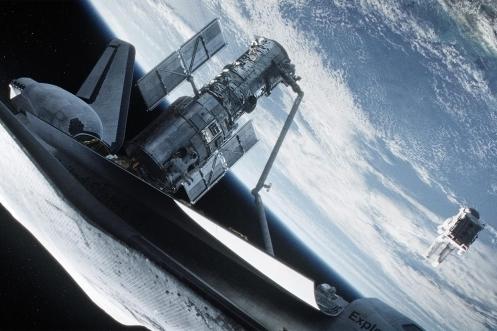
It seems strange to be writing this from the comfor of my sofa, yet only yesterday this was my view: repairing the Hubble Space Telescope in low Earth orbit, from the next generation shuttle, Explorer. And it was breathtaking. I had front row seats for the UK premiere of Alfonso Cuorón’s Gravity at London’s Odeon Leicester Square, as part of the bfi’s London Film Festival.
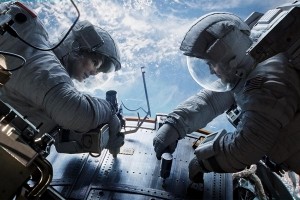 The first dozen minutes of the movie are a single, beautiful shot of Earth from space, viewed in glorious 3D. Wow. We dive into the scene and eventually stars Sandra Bullock and George Clooney are unscrewing a panel on the Hubble Space Telescope, that they’re up there to repair. A bolt spins out of Bullock’s reach and I’m on hand to catch it as it flies past me. Wonderful.
The first dozen minutes of the movie are a single, beautiful shot of Earth from space, viewed in glorious 3D. Wow. We dive into the scene and eventually stars Sandra Bullock and George Clooney are unscrewing a panel on the Hubble Space Telescope, that they’re up there to repair. A bolt spins out of Bullock’s reach and I’m on hand to catch it as it flies past me. Wonderful.
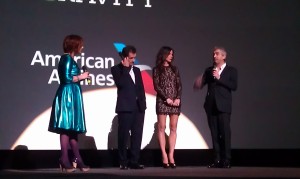
Last year I found myself on the red carpet with George Clooney for The Ideas of March. This year, I entered with Sandra Bullock while Harry Potter producer David Heyman was being interviewed in the doorway. Having taken my seat, Cuorón, Heyman and Bullock took to the stage and introduced the movie.
The visual effects are extraordinary. Tim Webber and his team are surely nailed on for next year’s Oscar, having come up with all manner of new techniques for relatively low costs, to create such a realistic spectacle. Life of Pi had beautiful conematography and 3D, but I think Gravity is better, but of course that’s also partly down to the low Earth orbit setting. make sure you see the film on the biggest screen you can find, and you won’t be disappointed.
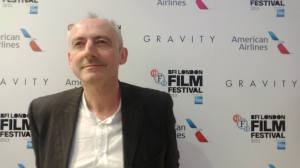 I have experience being in space, while at the cinema before. When I worked at the Science Museum I was able to slip into their IMAX whenever they were showing Walking on the Moon: 3D. It really was the next best thing to being there, but that used a lot of genuine footage. There are two related jokes about Gravity, such is the realism of the film: one is that NASA is going to sue once it discovers Cuorón’s hidden cameras aboard the International Space Station (ISS); the other is that he actually considered filming it in space.
I have experience being in space, while at the cinema before. When I worked at the Science Museum I was able to slip into their IMAX whenever they were showing Walking on the Moon: 3D. It really was the next best thing to being there, but that used a lot of genuine footage. There are two related jokes about Gravity, such is the realism of the film: one is that NASA is going to sue once it discovers Cuorón’s hidden cameras aboard the International Space Station (ISS); the other is that he actually considered filming it in space.
So far so good. I don’t know if I was so blown away with the experience that I didn’t pay much attention to the actual characters, or whether their story wasn’t particularly interesting. But while I’d give the visuals 11 out of 10, the backstory of lead characters Bullock and Clooney only seemed to merit a 4 or 5.
But the premise is good, so don’t let that put you off. Many scientists are becoming increasingly worried about space junk filling the area where most satellites are placed. There is a catastrophic scenario where the collision of two satellites, or one breaking up, could lead to a chain reaction with devastating consequences, where most if not all satellites would be destroyed. The movie opens with that happening and the debris careering towards the vulnerable shuttle. And even once it’s gone by, we and the astronauts know it will return within 90 minutes and none of us still want to be there.
You will find yourself ducking out of the way of space debris and maybe even longing to feel planet Earth under your feet again. Gravity must be seen for the beauty and brilliance of the visuals.


.jpeg?picon=3324)
By: Keith Mansfield,
on 9/22/2013
Blog:
Keith Mansfield
(
Login to Add to MyJacketFlap)
JacketFlap tags:
Science,
space,
Aliens,
Royal Observatory,
SETI,
Magellanic Clouds,
alien abduction,
astrophotography,
Ben Canales,
CETI,
David Kingham,
Guiding light to the stars,
hi hello,
Mark Gee,
National Maritime Museum,
Visions of the Universe,
Add a tag
When I was young it was my dream to meet aliens. In fact, the idea of being abducted by aliens and taken off round the galaxy was the root for the Johnny Mackintosh stories. But I also had this idea that ET would be as lovely and friendly as in the Spielberg movie of the same name. One of my favourite photographs at the Astronomy Photographer of the Year Awards earlier this week was hi hello by American Ben Canales. It’s a beautiful image that perfectly captures the longing not to be alone in the Universe – the aching to make contact.

The probability is that any aliens we encounter are likely to be vastly superior to us in every way. Even relatively tiny differences in abilities have led to the most dramatic consequences here on Earth. Look at the way the “old world” of Europe quickly dominated and devastated the cultures of the “new world” of the Americas. Or how with a relatively very small difference in brain power compared with our chimpanzee cousins, we dominate the planet while they pick fleas off each other (and we never invite them round for tea).
Of course aliens may not intentionally wish to destroy us, but just going about their business could have terrible consequences that they might not even realize, as we’d likely be so very alien to them. However, if some warlike ones came calling, I couldn’t help thinking it might look something like this submission from David Kingham:

This brilliant image of the Perseid meteor shower (combining 23 separate exposures) looks like an alien missile bombardment.
If you saw the wonderful Visions of the Universe down the hill at the National Maritime Museum, that used many photographs from the first four years of the Astronomy Photographer of the Year competition. “Visions” has just finished, but now you can see the brilliant new APotY exhibition (though without a glass of champagne in hand) at the Royal Observatory until 23rd February 2014.
Should we attempt to communicate with ET? Various attempts have been made over the years, from sending radio telecrope messages to specially targeted star systems and the plaque on the side of the Voyager space probes. But really these are irrelevant and the point is moot. For over a century, Earth has been lit up in the cosmic firmament, like a beacon or lighthouse, brightly beaming our radio and then television programmes into space. Are they a warning or an invitation? When aliens watch Independence Day or Star Wars, or the latest episodes of The Simpsons, what do they think? Are they eagerly awaiting the next instalment of Monty Python’s Flying Circus?
The overall winner of the competition was this Guiding Light to the Stars by Mark Gee. It’s a southern hempisphere Milky Way anchored by a lighthouse on the right-hand side, leading all the way to the Magellanic Clouds:

In the northern hemisphere we can see the Andromeda galaxy, the Milky Way’s twin, but south of the equator are these two smaller galaxies (upper left), probably satellites, possibly just hurtling by. While the distances between stars compared with their sizes are unimaginably vast, the relative distances between galaxies, certainly within our “local” group, are comparatively small.
If aliens came calling to take me I’d still go with them in a heartbeat, whether that was just around the Milky Way, or a little farther afield.


.jpeg?picon=3324)
By: Keith Mansfield,
on 5/6/2013
Blog:
Keith Mansfield
(
Login to Add to MyJacketFlap)
JacketFlap tags:
Add a tag
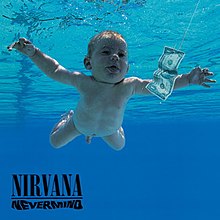 It’s often said that an author isn’t well-placed to adapt their books for the big screen. There are various reasons, but one is that we can be very precious about our stories, not wanting to leave the tiniest detail out, and that’s pretty difficult in a 100 minute movie. If you’re going to do it (right) and your name’s not Jo Rowling, you have to “kill your babies” (of course any excuse to show off that Nirvana album cover).
It’s often said that an author isn’t well-placed to adapt their books for the big screen. There are various reasons, but one is that we can be very precious about our stories, not wanting to leave the tiniest detail out, and that’s pretty difficult in a 100 minute movie. If you’re going to do it (right) and your name’s not Jo Rowling, you have to “kill your babies” (of course any excuse to show off that Nirvana album cover).
I mentioned over at JohnnyMackintosh.com that I’m working with a production company on a movie and I have to say it’s terrific fun. Happily the script won’t be solely down to me. Also, I’ve written a little for television before and worked for the British Film Institute, so hope I know what makes for a good film. People often think the secret to a good script is the dialogue. If only it were true as I think authentic dialogue is one of my strengths. But when you’re writing for cinema, it’s the images that need to tell the story, not the spoken words.
 I went to see Oblivion the other day and enjoyed it far more than I expected, given some poor reviews, but what surprised me was the opening ten minutes of voice-over explanation by Tom Cruise to set the scene. the golden rule of any storytelling is “show not tell”, yet that movie did exactly the opposite. Buoyed by wondering what the Johnny Mackintosh movie poster would look like, I’m including the very first draft of the opening here. I would never normally make such early material public (and may well regret it), so take a look quickly before I decide it’s rubbish and I should take it down.
I went to see Oblivion the other day and enjoyed it far more than I expected, given some poor reviews, but what surprised me was the opening ten minutes of voice-over explanation by Tom Cruise to set the scene. the golden rule of any storytelling is “show not tell”, yet that movie did exactly the opposite. Buoyed by wondering what the Johnny Mackintosh movie poster would look like, I’m including the very first draft of the opening here. I would never normally make such early material public (and may well regret it), so take a look quickly before I decide it’s rubbish and I should take it down.
Opening scene from the Johnny Mackintosh Movie (draft 1).
You can compare this with the opening of the original book by reading an eBook sample. Or, if you’re reading this post on the day it’s written, the book is actually the Amazon Kindle Daily Deal, so you might as well buy it!
There’s no need for captions or voiceovers. the pictures should tell the whole story, introducing Johnny (and Bentley), his love of fish ‘n chips and football (not necessarily in that order), and that he lives in a children’s home where he’s programmed the computer to search for signals from aliens. While screenwriting guru Syd Field talks about entering a scene as late as possible and leaving as early as you can, here I’ve gone back a couple of minutes before the start of the book in the expectation it makes things clearer and will save a lot of time with the setup later on.
Nowadays I tend to read scripts instead of books. There are plenty of web resources that have them, including the BBC Writers Room which is always a handy place to visit.


.jpeg?picon=3324)
By: Keith Mansfield,
on 5/4/2013
Blog:
Keith Mansfield
(
Login to Add to MyJacketFlap)
JacketFlap tags:
Add a tag
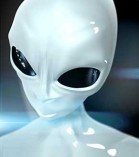 The most important question facing all of science is finding evidence for intelligent alien life. Before someone who’s chanced upon this webpage dismisses me as a fruitcake (rather than a Cambridge-educated mathematical physicist and currently Science Publisher at Oxford Unversity Press), let me add that the very first conference organized by the Royal Society for its 350th anniversary year was on this very question – and I was there.
The most important question facing all of science is finding evidence for intelligent alien life. Before someone who’s chanced upon this webpage dismisses me as a fruitcake (rather than a Cambridge-educated mathematical physicist and currently Science Publisher at Oxford Unversity Press), let me add that the very first conference organized by the Royal Society for its 350th anniversary year was on this very question – and I was there.
The whole of science is founded on what we call the Copernican Principle, after Polish astronomer Nicolaus Copernicus who first proposed that Earth orbited the Sun, rather than the other way around. In doing so, Copernicus was the first person to say humanity has no privileged position in nature when, until this point, Earth had always been the centre of the Universe. Recognizing Earth as simply one of many planets orbiting the Sun, which in turn we came to understand orbits the Milky Way (in turn a part of the Virgo Supercluster and so on), allowed us to talk about the laws of nature as applying equally everywhere, rather than differently on Earth compared with in the heavens.
The Sun is one of a few hundred billion stars in the Milky and, partly through the Kepler Space Telescope, we now understand that most of those stars are accompanied by planets. Then the Milky Way is one of many hundreds of billions of galaxies in the visible Universe.The numbers are so vast as to be almost unimaginable. If intelligent life can come into being here on Earth, it seems inconceivable that it hasn’t happened elsewhere, myriad times across the Galaxy let alone the wider Universe. There’s even a mathematical expression known as the Drake equation that is intended to give the number of intelligent civilizations in the Milky Way:
 According to Frank Drake, the number N of detectable civilizations in the galaxy is the product of:
According to Frank Drake, the number N of detectable civilizations in the galaxy is the product of:
R* (the rate of star formation)
fp (the fraction of stars that have planets)
ne (the average number of earth-like planets per star – ie planets capable of supporting life)
fl (the fraction of those Earth-like planets on which life develops)
fi (the fraction of those planets that have life on which intelligent life develops)
fc (the fraction of those planets with intelligent life that create communications technology)
L (the average lifetime of an advanced civilization)
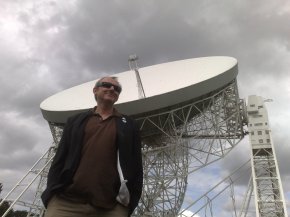 Let’s make up (and in most cases I do mean invent) some numbers. Say there are 10 new stars in the Galaxy each year (that’s roughly what scientists think); that three-quarters of the stars formed have planets; taking our own solar system as average there’s 1 Earth-like planet per solar system; recognizing life developed very soon on Earth after the planet formed we’ll go with this fraction as 0.8; equally, it took many billions of years for life here to go from single-celled organisms to complex, so let’s call the fraction on which intelligent life develops as 0.001, or one in a thousand; there are various “intelligent” species on Earth, but dolphins are never going to build radio telescopes, so let’s say one in four eventually develop communications technology; finally, once a civilization is able to communicate (perhaps with radio telescopes such as at Jodrell Bank here), I’ll suppose that they remain capable/willing to do this for 100,000 years. Plug those together and we get:
Let’s make up (and in most cases I do mean invent) some numbers. Say there are 10 new stars in the Galaxy each year (that’s roughly what scientists think); that three-quarters of the stars formed have planets; taking our own solar system as average there’s 1 Earth-like planet per solar system; recognizing life developed very soon on Earth after the planet formed we’ll go with this fraction as 0.8; equally, it took many billions of years for life here to go from single-celled organisms to complex, so let’s call the fraction on which intelligent life develops as 0.001, or one in a thousand; there are various “intelligent” species on Earth, but dolphins are never going to build radio telescopes, so let’s say one in four eventually develop communications technology; finally, once a civilization is able to communicate (perhaps with radio telescopes such as at Jodrell Bank here), I’ll suppose that they remain capable/willing to do this for 100,000 years. Plug those together and we get:
10 x 0.75 x 1 x 0.8 x 0.001 x 0.25 x 100000 = 150
That would suggess there are 150 species spread across the Milky Way who could communicate with us right now (but remember most of my numbers are pure guesswork). Apparently the average of estimates comes out at around 10,000, so I’m possibly being cautious, and one of my estimates that could be considered low is my number here for L. If even a few civilizations find ways not to destroy themselves so they can transcend their original home and spread out into the wider galaxy, that would seriously increase the number for L.
Considering the age of the Milky Way, the Sun is a comparatively young star meaning Earth is a new kid on the block when we think about galactic planet formation. We would expect plenty of civilizations to have formed before ours. If L is large they might still be around, but in this case we would surely see evidence of large-scale engineering projects happening in the galaxy. Yet, when we turn our ever more powerful telescopes skyward, we completely fail to find any evidence of and reorganization of the Galaxy by advanced races.
Some people argue that even if L is small it doesn’t matter. The mathematical physicist John Von Neumann developed the idea of self-replicating machines and this has been applied to autonomous space probes that an advanced alien race could send out into the galaxy to explore/conquer/assist other civilizations. Using this method, the entire Milky Way could be explored within only a few million (yes million, not billion) years, even if the originating civilization had long since died out. But again there is no evidence of such probes anywhere.
If science cannot find evidence for aliens, then the premise of the Copernican revolution is called into question, and we have to recognize ourselves and our homeworld as special after all, which goes on to call into question our entire view of the Universe and basis for understanding it.
One of the most interesting people investigating this area is the brilliant Serbian astronomer Milan Cirkovic, so check him out if you want to know more. This post is called “Where is everybody?” because that is supposedly a question posed by phyisicist Enrico Fermi over lunch with colleagues at Los Alamos National Laboratory. The conversation had turned to the apparent likelihood of intelligent alien life, yet the total absence of evidence for this. This is nowadays known as the “Fermi paradox”.
I have two very different and equally interesting solutions to the problem, both of which I intend to turn into novels or film scripts, so I shall say no more about them for the time being.


.jpeg?picon=3324)
By: Keith Mansfield,
on 8/27/2012
Blog:
Keith Mansfield
(
Login to Add to MyJacketFlap)
JacketFlap tags:
Add a tag

One giant leap
Like many people, the earliest event (I think) I remember is Neil Armstrong climbing down a ladder, jumping off the end, slightly botching his lines but being the very first human being to set foot on another world. That was more than 43 years ago but the shocking fact remains that only 12 people have walked on ground that wasn’t Earth’s, all of them only went to the Moon and no one has done this for more than four decades.
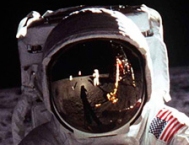 Neil Armstrong died a couple of days ago. It brings into focus how long ago the Moon landings were. We went from the first powered flight in 1903 to the first flight over the Atlantic in 1927 to the first Moon landing in 1969. And then nothing. The pace of progress in the modern world is often frightening. I look at my android phone and think in many ways the future has arrived early, but there’s a gaping hole in all of this and it’s that we haven’t colonized the solar system.
Neil Armstrong died a couple of days ago. It brings into focus how long ago the Moon landings were. We went from the first powered flight in 1903 to the first flight over the Atlantic in 1927 to the first Moon landing in 1969. And then nothing. The pace of progress in the modern world is often frightening. I look at my android phone and think in many ways the future has arrived early, but there’s a gaping hole in all of this and it’s that we haven’t colonized the solar system.
In the aftermath of Armstrong’s death I was watching a BBC Sky at Night broadcast from not long after the second Moon landing called “1969, the Year of Space”. Presenter Patrick Moore delivers the line,
“The Americans plan to get a man on Mars between 1985 and 1990 and I’m sure they’ll do it.”
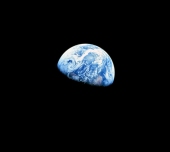 Now we’re probably looking at 2050. Does it matter? I want to shout an enormous “YES!” from the rooftops. The very survival of humanity as a species depends on it. That’s a simple statement of fact. There’s a proverb that it’s best not to keep all your eggs in one basket and right now all the humans in the universe are either on or flying around planet Earth. It’s when you view the photos of our world from the Apollo spacecraft that you realize just what a fragile basket we inhabit. If something happens to this one, island Earth, then that could be curtains for us. What sort of thing do I have in mind? Well, I’ve published a book on Global Catastrophic Risks so if you’re interested you can take a look. But if we don’t get off-planet it is a mathematical certainty that humans will one day become extinct.
Now we’re probably looking at 2050. Does it matter? I want to shout an enormous “YES!” from the rooftops. The very survival of humanity as a species depends on it. That’s a simple statement of fact. There’s a proverb that it’s best not to keep all your eggs in one basket and right now all the humans in the universe are either on or flying around planet Earth. It’s when you view the photos of our world from the Apollo spacecraft that you realize just what a fragile basket we inhabit. If something happens to this one, island Earth, then that could be curtains for us. What sort of thing do I have in mind? Well, I’ve published a book on Global Catastrophic Risks so if you’re interested you can take a look. But if we don’t get off-planet it is a mathematical certainty that humans will one day become extinct.
One of the miracles of the modern world is the connections given us by Twitter. It’s currently the Edinburgh Book Festival whose account I follow, and the book festival tweeted a comment from one time British Labour Party cabinet minister, Michael Meacher:

 I don’t know anything about Meacher’s ideas on sustainability but the incorrect assumption in the statement annoyed me – that we are in an “unsustainable bubble”. Since the Industrial Revolution, gloriously portrayed in Danny Boyle’s recent Olympic Opening Ceremony, we have embarked on a path of economic growth. We have gambled humanity’s future by mining over the course of a few decades, resources that took millions of years to create. Was it a gamble worth taking? I would say yes because we have become immeasurably wealthier as a race. For instance, if you’d given people blueprints for the Space Shuttle in the middle ages, it would have been impossible to build one, not because the plans couldn’t in time have been understood, but because they couldn’t afford it! Similarly for cures for polio or smallpox.
I don’t know anything about Meacher’s ideas on sustainability but the incorrect assumption in the statement annoyed me – that we are in an “unsustainable bubble”. Since the Industrial Revolution, gloriously portrayed in Danny Boyle’s recent Olympic Opening Ceremony, we have embarked on a path of economic growth. We have gambled humanity’s future by mining over the course of a few decades, resources that took millions of years to create. Was it a gamble worth taking? I would say yes because we have become immeasurably wealthier as a race. For instance, if you’d given people blueprints for the Space Shuttle in the middle ages, it would have been impossible to build one, not because the plans couldn’t in time have been understood, but because they couldn’t afford it! Similarly for cures for polio or smallpox.
But the resources we greedily consume cannot last for ever, so it might seem on the surface that Meacher is right. If you view the Earth as a closed system in game theory terms then he would be. In what’s known as a “zero-sum game”, not everyone can keep winning – for the upside of what we take from the planet there will be a price to pay – a downside – later on. Stick to Earth and we are living in unsustainable times having already mortaged the future for our descendants. But there is an alternative.
There is vast wealth waiting for us in space, in terms of both energy and materials. The sum of the game is no longer zero – it is effectively infinite and to reach out and grasp it is a win–win “for all mankind”. The choice before us is clear: (a) we can either continue with space exploration, develop fabulous new technologies and expand into and exploit the resources of the solar system (and hopefully beyond); or (b) we can turn our back on space for ever, rein in our development and try to live in a sustainable way within the finite means of just this one planet, in a depressing era of ever-diminishing returns.
As a species there can be no standing still, no stable equilibrium: either we progress or we’ll begin to decline. My sense is that we only have one shot at this. We have already used up so much of Earth’s resources that if we were to quit now and decline into some sort of pre-industrial era for a millennium or three, it will be far harder for humans (or whatever was to come after us) to begin again and reach for the stars.
After Apollo was prematurely cancelled, America reined in manned space exploration. I sense that the tide is turning and hope that it’s not already too late. The next flag on the Moon is likely to be Chinese or Indian, but while it is partly a matter of national pride, these nations are trying to go because they realize it is also an economic necessity.
Armstrong’s great legacy was that he inspired a generation of humanity to reach for the stars. Now he’s gone it’s up to those of us he touched to argue the case. As a child after the Apollo landings I didn’t want simply to be an astronaut – I expected to one day command a Moonbase. Now I shall argue all I can for one to be built within my lifetime.
[All the space images in this post are courtesy of NASA]


.jpeg?picon=3324)
By: Keith Mansfield,
on 8/27/2012
Blog:
Keith Mansfield
(
Login to Add to MyJacketFlap)
JacketFlap tags:
Add a tag
The news over this bank holiday weekend has been dominated by the sighting of “The Essex Lion“, a big cat apparently seen by several people in St Osyth near Clacton-on-Sea. Remarkably, it’s almost four years to the day since I also saw a big cat in Britain, on the first day of a holiday in north Staffordshire. I tried to contact a few people about it when I returned home and ended up talking to BBC Radio Stoke about it.
Two of us saw the creature, which was a massive sandy-coloured cat-like animal (maybe 7 feet long?) prowling in a meadow immediately south of Rudyard Lake. You would think the instant reaction would be to pull out a camera and start snapping, but it’s hard to convey how completely shocking it is to see what looks like a lion simply wandering around in a field. We watched it fow a couple of minutes before I finally came to my senses and pulled my (switched-off) phone from my bag. When you’re waiting for something to boot up we’ve probably all scuppered the process by pressing buttons too quickly, and that’s what I did here. So by the time I managed to capture something it was a video of the very last few seconds at the far edge of the field, and no accompanying still images. But here’s the video:

I thought this was pretty important so wrote down as accurate as possible a witness report at the time. I’m reproducing it in unedited form below:
We were walking between the carpark of the Rudyard Steam Railway, alongside the railway track (the trains are very narrow gauge and this is an official footpath) up to the Rudyard Lake dam for a picnic lunch. The railway track is elevated, but tree-lined on either side. Walking north, the actual rails are on the right-hand side so you walk alongside the left line of trees which has gaps from time to time enabling you to look out across a meadow to the left. We’d never been here before and don’t know the area particularly well (it had been recommended as a place to break our journey).
We started walking just after midday (about 12.45 pm). It was a reasonably clear day with good light and visibility. After three or four hundred metres, at an opening in the trees on our left, we simply stopped and stared.
A large cat-like creature (you couldn’t call it a cat as it was as big if not bigger than a large dog) was prowling through the meadow beneath us. From the animal’s perspective, it would have been surrounded by fairly long grass so felt secure in not being seen easily. Because the railway line is elevated we had a crystal clear view of it, perhaps between eighty and a hundred metres away.
It was sandy coloured, with a long tail that curved down and then up. I can’t remember now (sorry) but there may have been a small splash of white on the tail, or it may have been all sandy. I’d have said it was at least six or seven feet long. An adjective I’d use to describe it would be “powerful”. After watching it on the prowl for a minute or so, the animal paused and sat briefly.
It also seemed very assured/confident in its surroundings. That was odd because it was so clearly out of place in North Staffordshire, that the whole thing seemed quite unreal. As it made its steady progress through the meadow, I was wondering what on Earth was going on and looking around for a film crew as I could only assume someone was trying to fake some exotic footage for a movie. Finally, while the creature had briefly paused, I came to my senses, dropped the packed lunch to the ground and rooted around my pockets for my mobile phone to record it. As I’d been driving it was turned off and, for the first time ever, the camera seemed to go wrong when I switched it on (probably opening the lens cover too early before it had booted up). The upshot of that was I sadly didn’t take any stills and I was only able to capture about the final 15 seconds on video (which perhaps foolishly I’d set on maximum zoom) as it moved off. My phone’s a Nokia N95 so reasonably high-spec, but let me down on this occasion. Considering how clearly we could see the animal, the footage doesn’t do it justice at all and looks very distant.
The animal ended up at what looked like a small stream or brook. It stopped there for a few seconds, then jumped down and up the other side and was gone.
I think we were in a state of shock and didn’t know what to make of it. We carried on up to the dam for our lunch and on the way back kept looking through the trees (camera properly at the ready now) to see if the unexpected creature would make a reappearance. Naturally, this time we were disappointed, though we saw a couple of cattle (with horns) that I hadn’t spotted earlier.


.jpeg?picon=3324)
By: Keith Mansfield,
on 8/6/2012
Blog:
Keith Mansfield
(
Login to Add to MyJacketFlap)
JacketFlap tags:
space,
Mars,
NASA,
JPL,
Publishing Industry,
Johnny Mackintosh,
Clara Mackintosh,
literary characters,
Mars Curiosity,
Gale Crater,
sheepdog on Mars,
Add a tag
In case you missed it, Johnny Mackintosh (and Clara and Bentley, and even me) only went and landed on Mars this morning: read all about it!
We’re all here, etched onto the back of the Mars Curiosity rover, in the Gale Crater:



.jpeg?picon=3324)
By: Keith Mansfield,
on 2/4/2012
Blog:
Keith Mansfield
(
Login to Add to MyJacketFlap)
JacketFlap tags:
exoplanets,
Kepler,
ABSW,
pecha kucha,
Giovanna Tinetti,
Ofer Lahav,
dark energy,
Geraint Jones,
Peter Grindrod,
Claire Cousins,
Exomars,
Lewis Dartnell,
extremophiles,
Science,
space,
Mars,
comets,
astrophysics,
astrobiology,
Add a tag
I realize I’m privileged to have access to some of the world’s cutting edge science, but last week was particularly special with a visit to University College London to hear a mixture of astrophysicists and astrobiologists talk to journalists about their cutting edge work,organized by the ABSW, the Association of British Science Writers, of which I’m a member.
Now we all know scientists can sometimes waffle, but this brave half-dozen weren’t allowed that luxury. The format for the talks was a pecha kucha – born in Japan, you have 20 slides, each lasting for exactly 20 seconds, to get your point across. That’s 6 minutes, 40 seconds (and not a second more) to say who you are, what you do and pitch for a place in the science columns of Britain’s newspapers.
 First up, Giovanna Tinetti asked what exoplanets are actually made of. For those out of the loop, exoplanets are those orbiting other stars, far beyond out own solar system. We weren’t sure such things even existed until the 1990s, but nowadays there are more than 700 confirmed cases, with hundreds more candidates awaiting confirmation. recently some astronomers have gone so far as to sayy that every star in our galaxy must have planets orbiting.The most productive way to search for these faraway worlds is by using the Kepler Space Telescope. Looking back along a populous spiral arm of the Milky Way, this other Hubble is a study in concentration, staring fixedly at a single window on the stars, watching for the most minute variation in their light. And by analying this light – the chemical clues hidden within the spectra, scientists like Giovanna can tell what planets hundreds of light years away are made from. She’s looking for those that are habitable. Soon, New Earth need not be a thing of science fiction stories, especially if Giovanna’s plans for ECHO, the Exoplanet Characterisation Observatory, are approved by ESA (the European Space Agency).
First up, Giovanna Tinetti asked what exoplanets are actually made of. For those out of the loop, exoplanets are those orbiting other stars, far beyond out own solar system. We weren’t sure such things even existed until the 1990s, but nowadays there are more than 700 confirmed cases, with hundreds more candidates awaiting confirmation. recently some astronomers have gone so far as to sayy that every star in our galaxy must have planets orbiting.The most productive way to search for these faraway worlds is by using the Kepler Space Telescope. Looking back along a populous spiral arm of the Milky Way, this other Hubble is a study in concentration, staring fixedly at a single window on the stars, watching for the most minute variation in their light. And by analying this light – the chemical clues hidden within the spectra, scientists like Giovanna can tell what planets hundreds of light years away are made from. She’s looking for those that are habitable. Soon, New Earth need not be a thing of science fiction stories, especially if Giovanna’s plans for ECHO, the Exoplanet Characterisation Observatory, are approved by ESA (the European Space Agency).
 Ofer Lahav, Professor of Astronomy at UCL, chose to talk about dark energy, the mysterious entity that apparently makes up three quarters of out universe, but which we didn’t even know was there until 1998. For me the most incredible, unexpected discovery of the last fifty years has been that the rate of expansion of the universe is increasing. No one expected this. Everyone wants to know why, but Ofer was impressively agnostic in his views. Either an entity we call dark energy permeates space itself, acting as Einsteins cosmological constant, or the best theories we have are very wrong. Once upon a time our best theory was Newton’s, but it couldn’t explain why Mercury orbited the Sun the way it did. Along came Einstein, General Relativity and a revolution in science. With the dark energy anomaly, are we on the cusp of another such paradigm shift?
Ofer Lahav, Professor of Astronomy at UCL, chose to talk about dark energy, the mysterious entity that apparently makes up three quarters of out universe, but which we didn’t even know was there until 1998. For me the most incredible, unexpected discovery of the last fifty years has been that the rate of expansion of the universe is increasing. No one expected this. Everyone wants to know why, but Ofer was impressively agnostic in his views. Either an entity we call dark energy permeates space itself, acting as Einsteins cosmological constant, or the best theories we have are very wrong. Once upon a time our best theory was Newton’s, but it couldn’t explain why Mercury orbited the Sun the way it did. Along came Einstein, General Relativity and a revolution in science. With the dark energy anomaly, are we on the cusp of another such paradigm shift?
.jpeg?picon=3324)
By: Keith Mansfield,
on 10/28/2011
Blog:
Keith Mansfield
(
Login to Add to MyJacketFlap)
JacketFlap tags:
Add a tag
[...] of Warner records, stood on the very front row for U2 at Glastonbury and even had to step in as John Taylor’s body double for Duran Duran (I told you I was a lucky so-and-so), but it’s this sort of gig, down in the basement of a small [...]
.jpeg?picon=3324)
By: Keith Mansfield,
on 10/28/2011
Blog:
Keith Mansfield
(
Login to Add to MyJacketFlap)
JacketFlap tags:
music,
London,
Duran Duran,
Ride,
Gig reviews,
Glastonbury,
Nottingham,
Alphastate,
British Sea Power,
Chris Davis,
Chris Moore,
Karl Skivington,
Katty Heath,
nugaze,
Rob McCleary,
shoegaze,
Add a tag
In June of this year I found myself knee deep in mud, struggling from my Glastonbury tent towards the faraway, more interesting areas of the vast festival site. I could go no further, marooned in the one place you don’t want to get stuck at Glastonbury – the dance field (well, I suppose the inside of the portaloos might be worse). Yet here, in this foreign field, I somehow zeroed in on one corner where richer sounds were concealed, chancing upon the BBC Introducing Tent. And there I discovered Spotlight Kid.

That was how I came to be at the Hoxton Underbelly last Friday. Sometimes people describe me as “lucky” so I suppose it was no surprise that, having discovered a great new band originating from my home town of Nottingham, I would swiftly find them playing just round the corner from my adopted Spitalfields. After the fates had conspired, it would have been rude not to attend.
Rude, but possible. There was a parallel invite from ITV to spend the night in the Jonathan Ross green room (the real one rather than what you see on stage) with Noel Gallagher (who did so much to revive British music at its most dead), Michael Sheen (who did a magnificent portrayal of the great Cloughie himself) and Miranda Hart (who did so little to win all those comedy awards) but I reasoned I can go to Wossy any week when he’s filming. But then there was an also a British Sea Power gig at the Barfly in Camden and they are quite possibly Britain’s absolute best band, but I have seen them maybe a dozen times before. Nottingham’s finest won out.
 This year I’ve been invited to see Muse in the private Wembley box of the head of Warner records, stood on the very front row for U2 at Glastonbury and even had to step in as John Taylor’s body double for Duran Duran (I told you I was a lucky so-and-so), but it’s this sort of gig, down in the basement of a small club with an energetic hungry young band that will always excite the most.
This year I’ve been invited to see Muse in the private Wembley box of the head of Warner records, stood on the very front row for U2 at Glastonbury and even had to step in as John Taylor’s body double for Duran Duran (I told you I was a lucky so-and-so), but it’s this sort of gig, down in the basement of a small club with an energetic hungry young band that will always excite the most.
Spotlight Kid (the Spotters on Tour) had support: the long running order comprised four hungry bands, but I missed the first (apologies to La Bete). Next up came three-piece Alphastate, with singer Ani announcing it was her birthday. She sang well, but spoke quietly and moved little, but I liked her dreamy folky vocals. And that she asked if anyone had been lucky enough to get Stone Roses tickets earlier in t
.jpeg?picon=3324)
By: Keith Mansfield,
on 10/23/2011
Blog:
Keith Mansfield
(
Login to Add to MyJacketFlap)
JacketFlap tags:
Odeon Leicester Square,
London Film Festival,
Movie Premiers,
The Thick of It,
Julius Caesar,
Paul Giamatti,
Film,
America,
Previews,
George Clooney,
Evan Rachel Wood,
Cinema,
The West Wing,
Philip Seymour Hoffman,
Sandra Hebron,
British Film Institute,
bfi,
Beau Willimon,
Alistair Campbell,
Malcolm Tucker,
Add a tag

I’ve always disliked The West Wing, primarily because it peddles the myth of brave and decent politicians, always doing the right thing in difficult circumstances. In reality I suspect the public prefer not to think about the dirty deals and corrupt and seedy goings on behind closed doors, which makes The Thick of It more my cup of tea – maybe that’s the UK/US divide? Of course I’m not saying most politicians don’t enter the fray with the best of intentions, but they universally seem to disappoint and the longer they hang around, the more they disappoint. Power corrupts. Even the scent of power corrupts.
 So full marks to Ides of March for telling the down and dirty, shabby story of how politics always seems to turn out. Last Wednesday I joined George Clooney, Philip Seymour Hoffman and Evan Rachel Wood on the red carpet for the UK premier. To really appreciate a movie, I try to read as little as I can about it beforehand, so I can watch at face value. Because of that I can admit my ignorance by believing we were likely to have some kind of retelling of the Julius Caesar story (by coincidence the play I studied for my O level Shakespeare), so I entered the Odeon Leicester Square confident of making the necessary connections between the film and the Bard. Not a bit of it.
So full marks to Ides of March for telling the down and dirty, shabby story of how politics always seems to turn out. Last Wednesday I joined George Clooney, Philip Seymour Hoffman and Evan Rachel Wood on the red carpet for the UK premier. To really appreciate a movie, I try to read as little as I can about it beforehand, so I can watch at face value. Because of that I can admit my ignorance by believing we were likely to have some kind of retelling of the Julius Caesar story (by coincidence the play I studied for my O level Shakespeare), so I entered the Odeon Leicester Square confident of making the necessary connections between the film and the Bard. Not a bit of it.
The bfi (the British Film Institute in official lower-case letters) is a great institution and a former employer of mine, but their organization often leaves a lot to be desired. I ended up being sent to various spots around central London to collect my tickets, meaning I only reached the red carpet about one minute before curtain up. I ran past George Clooney being interviewed without noticing, sat down in my seat and then saw the whole shebang being projected on the cinema screen.

As part of the bfi London Film Festival, my old colleague Sandra Hebron (it’s her last year as Artistic Director of the LFF) called Clooney up on stage where he proceeded to share a few jokes and introduce various cast and crew. Then the curtains parted and we were treated to 101 minutes of an intriguing thriller, even if the expected links to Shakespeare were missing.
This is the fourth film Clooney’s directed. In front of the camera he plays Democratic presidential candidate Mike Morris, Governor of Pennsylvania and leader in a two-horse race with a Senator from Arkansas. What I loved about the movie was that it’s not The West Wing – it shows just how sordid the realpolitik can be, and all credit to Clooney he’s right at the heart of it. The Ides of March of the title refers to the date of the key Ohio primary, which will fall on 15th March and help decide the contest.
The US Primary system has al
.jpeg?picon=3324)
By: Keith Mansfield,
on 10/5/2011
Blog:
Keith Mansfield
(
Login to Add to MyJacketFlap)
JacketFlap tags:
Add a tag
Hear, hear. Though I am inclined to the view that the result may well not be wrong. It is entirely in the spirit of science to be prepared to modify or throw out previous models as necessary, and I’ve been rather disappointed by a few physicist friends who want to dismiss it as an error immediately.
.jpeg?picon=3324)
By: Keith Mansfield,
on 9/25/2011
Blog:
Keith Mansfield
(
Login to Add to MyJacketFlap)
JacketFlap tags:
Science,
Opera,
CERN,
Descartes,
Albert Einstein,
relativity,
speed of light,
Feynman Diagrams,
imaginary numbers,
michelson-Morley,
nonlinear filtering,
special relativity,
Add a tag
 The science and even the popular press are filled with excitement at the moment after the OPERA experiment at Europe’s giant particle physics laboratory, CERN (to which I applied for a summer job when I was 16, but that’s another story). Apparently, neutrinos sent from CERN and captured at Italy’s INFN Gran Sasso Laboratory about 730 km away are arriving faster than scientists thought physically possible – faster than the speed of light travelling in a vacuum.
The science and even the popular press are filled with excitement at the moment after the OPERA experiment at Europe’s giant particle physics laboratory, CERN (to which I applied for a summer job when I was 16, but that’s another story). Apparently, neutrinos sent from CERN and captured at Italy’s INFN Gran Sasso Laboratory about 730 km away are arriving faster than scientists thought physically possible – faster than the speed of light travelling in a vacuum.
 I had to write about this because the news reporting has really annoyed me. Every announcement has said that Einstein might be wrong because he (special relativity) says nothing can travel faster than light in a vacuum. Poppycock! (As I’m being polite.) What the theory says is that nothing that has what scientists call “rest mass” can travel at the speed of light – there isn’t any block on things travelling faster. It’s always slightly surprised me that in a discipline where mathematical physicists are used to things called discontinuous functions, I rarely hear of people willing to accept that something could go from “slower” to “faster” without having to “equal”, but it might be possible.
I had to write about this because the news reporting has really annoyed me. Every announcement has said that Einstein might be wrong because he (special relativity) says nothing can travel faster than light in a vacuum. Poppycock! (As I’m being polite.) What the theory says is that nothing that has what scientists call “rest mass” can travel at the speed of light – there isn’t any block on things travelling faster. It’s always slightly surprised me that in a discipline where mathematical physicists are used to things called discontinuous functions, I rarely hear of people willing to accept that something could go from “slower” to “faster” without having to “equal”, but it might be possible.
One argument against travelling faster than light is that, although there are solutions to Einstein’s equations, they contain the square root of minus one which we sometimes call an “imaginary” number (as opposed to other numbers that are called “real”). This is a brilliant example of mathematical spin and how it has actually damaged our understanding of mathematics and the universe. There is nothing less real about these imaginary numbers than what are called the real ones. It’s actually by combining both set that we achieve a far deeper understanding of the mathematical and physical universe. But way back when they were first introduced, French mathematician and philosopher Rene Decartes was very distrustful of them so coined the term imaginary as a pejorative description, hoping it would mean they didn’t catch on. He’s got a lot to answer for.
What is a neutrino? Like the similarly named neutron, a neutrino carries no net electric charge (compared with other familiar subatomic particles such as electrons (-1) or protons (+1). Unlike the neutron, the neutrino has almost (but not quite) no mass. Having no charge and almost no mass makes a neutrino extremely difficult to detect.
Back to relativity! Anything travelling faster than light in relativity yields solutions including the square root of minus one which people have interpreted as meaning travelling backwards in time. That’s the reason for the joke that’s currently doing the rounds on the twittersphere:
Barman: “I’m sorry, sir. We don’t serve neutrinos in here.”
A neutrino walks into a bar.
.jpeg?picon=3324)
By: Keith Mansfield,
on 9/8/2011
Blog:
Keith Mansfield
(
Login to Add to MyJacketFlap)
JacketFlap tags:
Earth stops spinning,
Gripping Stuff,
Nessun Dorma,
Pirelli,
Tracy Ann Baines,
children's books,
TV,
advertising,
book blogs,
Publishing Industry,
Battle for Earth,
Add a tag
.jpeg?picon=3324)
By: Keith Mansfield,
on 8/31/2011
Blog:
Keith Mansfield
(
Login to Add to MyJacketFlap)
JacketFlap tags:
Add a tag
It’s ultra busy the day before publication of Johnny Mackintosh: Battle for Earth.
 On the Quercus Books blog (Quercus is my publisher) you can read my post about Doomed Teddy Bear Love.
On the Quercus Books blog (Quercus is my publisher) you can read my post about Doomed Teddy Bear Love.

On the brilliant Book Zone for Boys website you can read another of my posts, this time on the coolest way (we’ve yet come up with) to land on another planet.
 Then, over at www.JohnnyMackintosh.com, there’s a piece on Jo Rowling’s and Harry Potter’s influence on the Johnny Mackintosh books.
Then, over at www.JohnnyMackintosh.com, there’s a piece on Jo Rowling’s and Harry Potter’s influence on the Johnny Mackintosh books.
What are you doing still here? Go and get reading!








.jpeg?picon=3324)
By: Keith Mansfield,
on 8/27/2011
Blog:
Keith Mansfield
(
Login to Add to MyJacketFlap)
JacketFlap tags:
Add a tag
[...] Although there was a time when the ridiculous TV schedulers put it up against Gerry Anderson’s Space 1999 (Moonbase Alpha won that particular battle for me way back then) I’ve watched Who pretty much all [...]
.jpeg?picon=3324)
By: Keith Mansfield,
on 8/14/2011
Blog:
Keith Mansfield
(
Login to Add to MyJacketFlap)
JacketFlap tags:
Art,
Exhibitions,
Architecture,
Blade Runner,
Bono,
festivals,
Lord of the Flies,
art installations,
music festivals,
Shangri-La,
NYC Downlow,
The London Underground,
music,
Add a tag
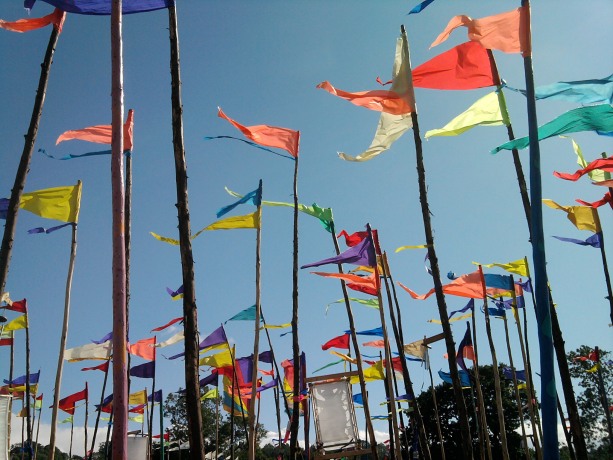
After finally downloading some of my pictures, here’s a belated post about summer fun. If you’ve never been to the Glastonbury Festival you might be labouring under the misapprehension that it’s a music event. In fact, you could have a great time in the fields of Worthy Farm if you don’t do to see a band at all. A city of two hundred thousand people, three miles across, descends on the Somerset countryside and it is a city of wonders. I think the first time I went was 1992. I remember catching sight of the place and thinking I had stumbled upon Tina Turner’s Bartertown, from the Mad Max movies. There was just so much going on and here are a few pictures away from the music side:
 Much of this year’s art was on a gigantic scale, set in some sort of post apocalyptic dystopian future. Here in an area of the site known simply as Block9 is “The London Underground”, a 50ft tower block complete with a crashed Tube train near the top.
Much of this year’s art was on a gigantic scale, set in some sort of post apocalyptic dystopian future. Here in an area of the site known simply as Block9 is “The London Underground”, a 50ft tower block complete with a crashed Tube train near the top.

Opposite “The London Underground” is another extract from an urban cityscape, the magnificent “NYC Downlow”. Dare you cross the road to enter what for the Glastonbury campers might still appear to be luxury accommodation. Yes the bathroom’s exposed to the elements but, hey, at least there’s a bath.
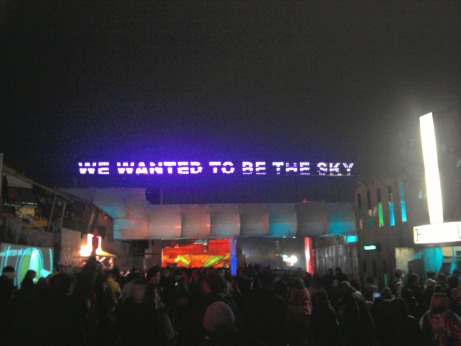 Shangri-La was a nearby area of the site that had “been contaminated”. It was a Blade Runner-style world with a mixture of hope and desperation. You entered underneath a neon banner proclaiming “We are all sky” which is something that’s always had a special resonance for me in my more poetic writing.
Shangri-La was a nearby area of the site that had “been contaminated”. It was a Blade Runner-style world with a mixture of hope and desperation. You entered underneath a neon banner proclaiming “We are all sky” which is something that’s always had a special resonance for me in my more poetic writing.
 There was a rumour (that I started) that Bono’s plane had been shot down on leaving the festival, ending up as another club in one of the outlying fields. Or maybe this is an allusion to Lord of the Flies, that if the mud becomes too deep we’ll all revert to savages. Whichever, I think the styling’s extraordinary.
There was a rumour (that I started) that Bono’s plane had been shot down on leaving the festival, ending up as another club in one of the outlying fields. Or maybe this is an allusion to Lord of the Flies, that if the mud becomes too deep we’ll all revert to savages. Whichever, I think the styling’s extraordinary.

Here’s your chance to begin again in the off-world colonies. Now we’ve seen the final space shuttle flight it might be the only way to go there.
.jpeg?picon=3324)
By: Keith Mansfield,
on 7/3/2011
Blog:
Keith Mansfield
(
Login to Add to MyJacketFlap)
JacketFlap tags:
Add a tag
Hi Angela – as the person who nominated Harry, I have to disagree. Rowling’s are the best-written children’s books I’ve come across and not at all for the literary challenged. However, on a bookshelf of a hundred titles, I’m sure there’s room for both her magic and Rushdie’s magic realism. You should ring the show and nominate Midnight’s Children.
.jpeg?picon=3324)
By: Keith Mansfield,
on 7/3/2011
Blog:
Keith Mansfield
(
Login to Add to MyJacketFlap)
JacketFlap tags:
Add a tag
I think that it is a terrible shame that the Harry Potter series, interesting as they may be for children and the somewhat literary challenged, are on a virtual bookshelf nominated for the whole country. I would like to nominate one of the best living writers in the English language today, namely Salman Rushdie and his wondrous book Midnights Children.
I have previously nominated this book along with many other listeners.
It is like a magical flying carpet transporting you from present day India, the lifestyle, customs, and festivals, to Pakistan and to Kashmir where the story begins. Everyday politics and lifes are interwoven with a fairytale concerning a boy born at midnight on the day of Indian independance from Britian and given supernatural gifts along with all the children born at or around the exact time.
It gives you an insight into India which makes you long to go there but also the magical gifts of the boy, and the stories connected with it are very reminiscent of the Arabian tales of one thousand and one nights.
I would be so happy if this very special book could make it on to the virtual bookshelf.
.jpeg?picon=3324)
By: Keith Mansfield,
on 5/8/2011
Blog:
Keith Mansfield
(
Login to Add to MyJacketFlap)
JacketFlap tags:
Johnny Mackintosh,
Christchurch earthquake,
Evans Randall,
Grosse Geiste,
Meg Ellis,
Thomas Schutte,
charity,
London,
New Zealand,
Architecture,
Aliens,
Gherkin,
Add a tag
 Have you ever wanted to peek inside Johnny Mackintosh’s spaceship, the Spirit of London? For those out there who don’t know, she sits at 30 St Mary Axe in the City, the capital’s financial district, and also goes under the name the London Gherkin.
Have you ever wanted to peek inside Johnny Mackintosh’s spaceship, the Spirit of London? For those out there who don’t know, she sits at 30 St Mary Axe in the City, the capital’s financial district, and also goes under the name the London Gherkin.
Three months after the dreadful events of 22nd February when Christchurch, New Zealand, was struck by an earthquake, the Gherkin is unlocking its revolving doors to make way for the Step up 4 Christchurch Earthquake Appeal. You have the chance to walk or run (there’s even a race) all the way up the 1037 steps to the top or, if that sounds a tad too much effort on a Sunday morning (shame on you), there’s an alternative route to the top via the lifts. Sadly, these will be the conventional type rather than the antigravity ones normally used on the Spirit of London.
 The event, taking place on Sunday 22nd May 2011, been organized by the Evans Randall Investment Bank so full marks to them. I was alerted to it by Meg Ellis who’ll be taking part as one of her 100 things for charity. There’s an entrance fee that goes to the earthquake appeal and, if you’re taking part, get yourself some extra sponsorship too.
The event, taking place on Sunday 22nd May 2011, been organized by the Evans Randall Investment Bank so full marks to them. I was alerted to it by Meg Ellis who’ll be taking part as one of her 100 things for charity. There’s an entrance fee that goes to the earthquake appeal and, if you’re taking part, get yourself some extra sponsorship too.
One last thing, watch out for aliens when inside, including this one in the lobby …








.jpeg?picon=3324)
By: Keith Mansfield,
on 4/17/2011
Blog:
Keith Mansfield
(
Login to Add to MyJacketFlap)
JacketFlap tags:
Add a tag

Another year, another London Book Fair. You could be forgiven for thinking that very little was different – that everyone’s still talking digital, but no one really knows what the true impact of eBooks will be. Well, that seems to be changing with a vengeance – the news that, in February of this year, eBook revenues overtook trade paperbacks in the US is a tremendous wakeup call for publishers everywhere.

A stripey Cory Doctorow
The Digital Conference, the precursor to the main fair, took place on the Sunday. Although I wasn’t there, much of the Twitter comment suggested that it was the same arguments being rehashed, though Evan Schnittman (ex of Oxford University Press and now at Bloomsbury) created quite a stir by apparently announcing the enhanced eBook is dead. This was just as people were getting their previews of ePub3, next version of the digital format of choice for most eBook retailers apart from Amazon Kindle (which has its own proprietary format).

I arrived at Earl’s Court on the Monday, in plenty of time for “the great debate”, whether publishers themselves will soon be irrelevant. Representing the industry were Andrew Franklin of Profile and Richard Charkin (also ex of OUP and now at Bloomsbury, but with rather more than Evan sandwiched in-between). The new media specialists on the other side of the camp were Cory Doctorow (founder of Boing Boing) and James Bridle, an editor and technologist.
We all know the industry has to change. Publishing is about connecting the creators of the content to those who need/want to use it – how it’s done can alter, but most of the audience seemed to think there will be a place for it. In my day job I’m a publisher at Oxford University Press, to which Charkin referred a fair bit, stressing the continued need for academic publishing. Franklin was more forthright that publishers are needed more than ever as arbiters of quality. Self-publishing is all very well, he claimed, except that no one would want to actually read the results – we sort the wheat from the chaff. The debate was a little like last year’s Prime Ministerial versions, with everyone queuing up to say “I agree with James” who spoke passionatel
.jpeg?picon=3324)
By: Keith Mansfield,
on 3/13/2011
Blog:
Keith Mansfield
(
Login to Add to MyJacketFlap)
JacketFlap tags:
music,
TV,
Brother,
Duran Duran,
Gig reviews,
Frank Lampard,
Chapel Club,
Christine Bleakley,
Die Zauberflöte,
Just an Illusion,
Leee John,
Paul Gambaccini,
Reborn in the USA,
Simon Price,
Sing it Back,
Spandau Ballet,
Tereza Bazar,
Tony Hadley,
Add a tag

I spent Saturday in the company of Duran Duran. Had you told me, back in the 1980s, that I’d do that, I wouldn’t have believed you. Yet, in recent years, I’ve had nights out with a fair few of the popstars I grew up listening to or watching on Top of the Pops. There’ve been the likes of Tony Hadley from Spandau Ballet, Leee John of Imagination (we danced together to “Just an Illusion” at the rap party of Reborn in the USA) or even the lovely Tereza Bazar from Dollar (who could forget that dress for Hand Held in Black and White?).
 Even so, Duran Duran are special and I’ll certainly treasure my crew pass. They were always a cut above the others. While not necessarily regarded as such in their home country, they were the biggest British band in the US since the Beatles. Never overtly cool, they had a superb brand of brilliantly crafted pop that I’ve always loved. In fact, over their thirty year career in music, I’ve enjoyed every Duran single, perhaps with special pleasure reserved for the brilliant “Ordinary World” that led to a revival at a time when it appeared they would fade away, when their music has always deserved to be heard.
Even so, Duran Duran are special and I’ll certainly treasure my crew pass. They were always a cut above the others. While not necessarily regarded as such in their home country, they were the biggest British band in the US since the Beatles. Never overtly cool, they had a superb brand of brilliantly crafted pop that I’ve always loved. In fact, over their thirty year career in music, I’ve enjoyed every Duran single, perhaps with special pleasure reserved for the brilliant “Ordinary World” that led to a revival at a time when it appeared they would fade away, when their music has always deserved to be heard.
 It’s thirty years since debut singe “Planet Earth”, a song the band sometimes mix with the underrated “All She Wants Is” in their live shows. There’s an element of sadness that, after all this time, the band are still worth writing about. I once scripted a TV show called Sing it Back with Paul Gambaccini, the walking encyclopedia of music who stated earlier this year that the era of rock ’n roll is over. It seems horribly true. It’s not just that I went to the opera a few weeks ago, and surprised myself by rather enjoying Mozart’s Die Zauberflöte. It’s that there’s very little interest or enthusiasm from the young generation in forming bands and actually crafting songs.
It’s thirty years since debut singe “Planet Earth”, a song the band sometimes mix with the underrated “All She Wants Is” in their live shows. There’s an element of sadness that, after all this time, the band are still worth writing about. I once scripted a TV show called Sing it Back with Paul Gambaccini, the walking encyclopedia of music who stated earlier this year that the era of rock ’n roll is over. It seems horribly true. It’s not just that I went to the opera a few weeks ago, and surprised myself by rather enjoying Mozart’s Die Zauberflöte. It’s that there’s very little interest or enthusiasm from the young generation in forming bands and actually crafting songs.
On Saturday, Duran played three of their new songs, all of which were impressive, especially “Leave a Light On” which I presume is a single to come soon. The band were recording Duran Duran: One Night Only at ITV’s London Studios, hosted by Christine Bleakley. Very professional, they were working pretty much all afternoon on sound checks and setup, but at times even this band with great stamina (as you’ll know if you’ve seen them live) need a break. At one point I was asked to take to the stage and mime a little bass playing, giving John Taylor a well-deserved rest. I’ve done some strange jobs over the course of my lifetime, but I never expected to become the body double for one of the world�
View Next 25 Posts
 It’s not a short film, but no one in the packed audience minded that the Q&A preceding it, with Professor Brian Cox and Dr Adam Rutherford, took over an hour. Huge credit to my former employers, the British Film Institute, for not making it token, but giving us the chance for a meaty discussion on what many think is the most important question facing science: where is everybody?
It’s not a short film, but no one in the packed audience minded that the Q&A preceding it, with Professor Brian Cox and Dr Adam Rutherford, took over an hour. Huge credit to my former employers, the British Film Institute, for not making it token, but giving us the chance for a meaty discussion on what many think is the most important question facing science: where is everybody?














 It’s often said that an author isn’t well-placed to adapt their books for the big screen. There are various reasons, but one is that we can be very precious about our stories, not wanting to leave the tiniest detail out, and that’s pretty difficult in a 100 minute movie. If you’re going to do it (right) and your name’s not
It’s often said that an author isn’t well-placed to adapt their books for the big screen. There are various reasons, but one is that we can be very precious about our stories, not wanting to leave the tiniest detail out, and that’s pretty difficult in a 100 minute movie. If you’re going to do it (right) and your name’s not  I went to see
I went to see 









 First up,
First up,  Ofer Lahav
Ofer Lahav




 The science and even the popular press are filled with excitement at the moment after the
The science and even the popular press are filled with excitement at the moment after the 



















